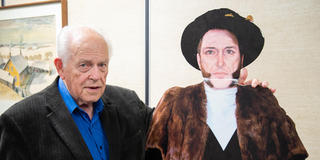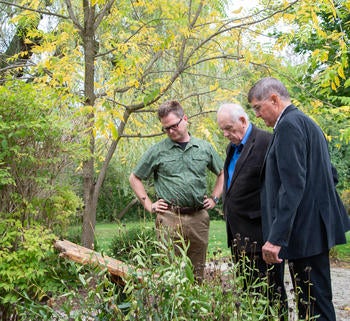“Conrad Grebel” University College was named for a church reformer in sixteenth-century Zurich, Switzerland. Grebel was an early leader of the Swiss Anabaptists, one of the radical Protestant groups who eventually became known as Mennonites.
No portraits or engravings of Conrad Grebel were made during his lifetime, and the most widespread picture of him is an imagined portrait painted in 1972 by the artist Tom Shenk. (We used that image to create a life-sized cutout of Conrad Grebel for our 50th Anniversary, back in 2013. The cutout still shows up occasionally at College events and is occasionally appropriated by students for pranks.)
 The model for that portrait was John L. Ruth, of Harleysville, Pennsylvania. This September, John visited the College, and I spent a good hour with him walking around campus and reconnecting. (I’ve known John since my childhood.) Now 89 years old, John is an ordained Mennonite minister, filmmaker, author, storyteller, and scholar. He received a PhD in English literature from Harvard in 1968.
The model for that portrait was John L. Ruth, of Harleysville, Pennsylvania. This September, John visited the College, and I spent a good hour with him walking around campus and reconnecting. (I’ve known John since my childhood.) Now 89 years old, John is an ordained Mennonite minister, filmmaker, author, storyteller, and scholar. He received a PhD in English literature from Harvard in 1968.
In addition to lending his face to the portrait of Conrad Grebel, John also wrote a historical novel. Conrad Grebel: Son of Zurich was commissioned by the College in 1975 to commemorate the 450th anniversary of the start of the Anabaptist movement (generally considered to begin when Conrad Grebel baptized the adult Felix Manz, on January 21, 1525).
John’s novel about Conrad Grebel was mildly controversial in 1975. Unlike an earlier Mennonite historian who had presented Grebel as a chaste and saintly character, John was open about his subject’s less admirable qualities, which included heavy drinking, brawling, and other bad behaviour while a student in Paris—prior to his spiritual awakening.
As John explained in his memoir: “I warmly identified with Conrad’s spiritual outlook, (but) I did not minimize his negative aspects. This scandalized some readers, and a professor at Conrad Grebel College called some of Conrad’s behaviour ‘criminal.’”
College professors might have also worried that Conrad Grebel was an unsuccessful student. He studied at three different universities but never completed any degrees. I have been told, more than once, that this College might never have been named for Grebel had these details of his life been more widely known at the time.
John Ruth’s willingness to face troubling moments in Mennonite history has recently drawn him to reconsider the early Mennonite settlement in Pennsylvania in the 1730s, on lands acquired by speculators and brokers in “shady” dealings with Indigenous peoples. He’s just finishing a book on that story, and he gave a presentation about it during his visit here. John admits that he only turned his mind to the shared history of Mennonites and Indigenous peoples late in his life and hopes that “our descendants can finally make more sense of it.”
Here in Waterloo, on the Haldimand Tract, Mennonites are beginning to reckon with a similarly neglected history of Mennonite settlement and Indigenous dispossession. At Grebel, we are committed to better understanding that history and to restoring relationships with Indigenous peoples in the present. It’s ongoing work that has included revisiting course curricula, amending historical signs at the College and at the Brubacher House Museum, and seeking connection with Indigenous neighbours here on campus and at the Six Nations community.
We study history and maintain archives at Grebel in order to deepen our grasp of the past and to make better sense of the present. We do this work even though it can take us to uncomfortable places as we confront historical facts that upend and disturb what we thought we knew. In that spirit, perhaps it’s oddly appropriate that this place is named for Conrad Grebel—both an important spiritual leader for Mennonites and a man with well-documented flaws. And perhaps it’s also fitting that the “face” of Conrad Grebel is a present-day Mennonite sage, now seeking to repair his memory as a settler on Indigenous lands.

Marcus Shantz, John Ruth, and Wilmer Martin ponder the revised plaque in Grebel's Swiss Mennonite Heritage Garden.






